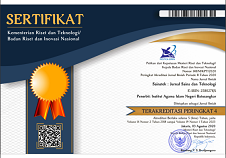PENGARUH MINYAK ATSIRI TERHADAP PERTUMBUHAN Colletotrichum gloeosporioides (Penz.) Sacc. PENYEBEBAB PENYAKIT ANTRAKNOSA BUAH PEPAYA (Carica papaya L.) SECARA IN VITRO
Abstract
This study aims to determine the effect of atsiri oils on the growth of mycelium and formation of aservulus Colletotrichum gloeosporioides causes anthracnose disease of papaya fruits in vitro. This study is an experimental study, using a completely randomized design (CRD) 3 x 4 factorial with replicates. The treatments tested were types of essential oils (Citronella, Cinnamon and Clove) and volume (0,3 mL, 9 mL and 18 mL). Data were analyzed with ANOVA and further test used is BNJ at the level of 5 % for the diameter of the colony and DNMRT at the level of 5 % for the amount of aservulus Colletotrichum gloeosporioides. The results showed the essential oil can inhibit the growth of mycelium and formation of aservulus Colletotrichum gloeosporioides. Clove oil in 3 mL volumes can significantly inhibit the growth of mycelium with a diameter of 10.07 cm 13.77 cm whereas control. Mycelium growth were treated with clove oil is slower than the citronella oil (12.67 cm) and cinnamon oil (13.7 cm). Clove oil in 9 mL volume can significantly inhibit the formation of mold aservulus the number 71 aservulus while control aservulus 527.67. Aservulus formation of fungus treated with clove oil is slower than the citronella oil (116 aservulus) and cinnamon oil (263 aservulus).
Key words : essential oils, Colletotrichum gloeosporioides, antraknosaFull Text:
PDF (Bahasa Indonesia)References
Chrisnawati. 2004. Pengujian Efikasi Formula Pestisida Nabati Minyak Seraiwangi Ter-hadap Gloesporium piperatum Penyebab Penyakit Antraknosa Cabe Secara In Vitro. Prosiding Seminar Ekspor Teknologi Gambir, Kayumanis dan Atsiri. Hal 121-129. Balai Penelitian Tanaman Rempah dan Obat Sumatera Barat.
Dahlan S, Nasrun dan Syafri E. 1998. Pengu-jian Minyak Atsiri Daun Beberapa Jenis Tanaman terhadap Jamur Fusarium oxysporum Penyebab Penyakit Layu Tanaman Cabai (Capsicum annum L.) secara In Vitro. Prosiding Seminar Sehari Perhimpunan Fitopatologi Indonesia: 131-136. Padang: Perhimpu-nan Fitopatologi Indonesia.
Guenther E. 1990. Minyak Atsiri. Jakarta: Penerbit Universitas Indonesia.
Istianto M, Eliza dan Hermanto. 2006. Eva-luation of Essential Oils for Antifungal Activity Againts Antracnose Disease (Colletotrichum sp) Attacks Banana Fruit in Storage. Balai Penelitian Tanaman Buah Tropika Solok. (sedang dalam proses publikasi).
Manohara D, Dono W dan Sukamto. 1993. Pe-ngaruh Tepung dan Minyak Cengkeh ter-hadap Phytopthora, Rigidoporus, dan Sclerotium. Prosiding Seminar Hasil Penelitian dalam Rangka Pemanfaatan Pestisida Nabati: 19-27. Balai Penelitian Tanaman Rempah dan Obat Bogor.
Mayuni. 2006. Teknologi dan Analisa Minyak Atsiri. Andalas University Press, Padang.
Nurmansyah. 2004. Pengaruh Penambahan Mi-nyak Serai Wangi dan Limbah Kayu manis terhadap Daya Antifungal Pes-tisida Nabati Siri Sirih. Prosiding Seminar Ekspor Teknologi Gambir, Ka-yumanis dan Atsiri: 86-92. Balai Pe-nelitian Tanaman Rempah dan Obat Solok.
Nurmansyah, Jamalius dan Hilma. 1998. Pe-ngaruh Minyak Daun Ranting dan Kulit Batang Kayumanis terhadap Patogen Fusarium oxisporum Schl Penyebab Penyakit Busuk Batang Panili dan Busuk Kering Rimpang Jahe. Prosiding Seminar Sehari Perhimpunan Fitopatologi Indo-nesia: 179-186. Perhimpunan Fitopa-tologi Indonesia, Padang.
Robinson T. 1995. Kandungan Organik Tum-buhan Tinggi. Bandung: Penerbit ITB.
Rukmana R. 1995. Pepaya Budidaya dan Pascapanen. Yogyakarta: Penerbit Ka-nisius.
Satuhu S. 1998. Penanganan Mangga Segar untuk Ekspor. Jakarta: Penerbit Swadaya.
Semangun H. 1994. Penyakit Penyakit Tana-man Hortikultura di Indonesia. Jakarta: Gadjah Mada University Press.
Semangun H. 1996. Pengantar Ilmu Penyakit Tumbuhan. Gadjah Mada University Press. Yogyakarta.
Wilson CI, Solar JM, El-Ghaoth A dan Wisniewski ME. 1997. Rapid Evaluation of Plant Extracts and Essential Oil for Antifungal Activity Againts Botrytis cinerea. Plant Disease 81: 204-210.
Wiyono S. 2004. Optimisation of Biological Control of Damping-off of Sugar Beet Caused by Phytium ultimum Trow by Using Pseudomonas fluorescens B5. Disserttion. George-August University Gottingen, Gottinge.
DOI: http://dx.doi.org/10.31958/js.v6i1.104
Refbacks
- There are currently no refbacks.
Copyright (c) 2016 Heffi Alberida, Eliza Eliza, Ria Nati Lova

This work is licensed under a Creative Commons Attribution-NonCommercial-NoDerivatives 4.0 International License.
Indexed by:
__________________________________________________________________________
Sainstek: Jurnal Sains dan Teknologi
ISSN 2085-8019 (print) | 2580-278x (online)
Published by Institut Agama Islam Negeri Batusangkar
Email: sainstek@iainbatusangkar.ac.id
This work is licensed under a Creative Commons Attribution-NonCommercial-NoDerivatives 4.0 International License.















